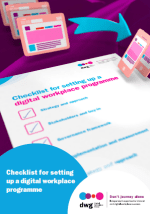6 key themes underpinning an effective digital workplace strategy
As the Digital Renaissance of Work gathers (digitized) steam, we take a step back to share a number of key themes underpinning a structured, well thought-out digital workplace.
One of the big takeaways from a recent survey of DWG Members’ key priorities for this year and our top posts of 2014 was that, while practical guidance for successful intranets is still needed, there is also a fast emerging stream of voices asking for thought leadership around the wider digital workplace and digital workplace strategy.
An oft overlooked fact is that, unless they’re still using telegrams and typewriters, every organization already is a digital workplace. However, if not approached thoughtfully and strategically, many run the risk of becoming the same “wild, wild west” of ungoverned intranets of years past. This is why the DWG Member research programme for 2015 will contain reports on Governance across the digital workplace and Defining the digital workplace roadmap, alongside operational reports such as an Intranet template toolkit.
While our researchers get their heads down and hands dirty on these focused reports, our Head of Research Elizabeth Marsh and CEO/Founder Paul Miller have written a series of six articles for CMS Wire that unpick a number of key themes underpinning the effective, structured, digital workplace.
Leadership
Top 7 characteristics of great digital workplace leaders
Time and again, we hear about the importance of leadership as a component of both effective intranets and digital workplaces. Having the right people lend visible, vocal and valiant support to an initiative can often be the difference between joy and pain.
But what exactly constitutes “leadership” in this context? In his article, Paul unpicks the characteristics that coalesce within great digital workplace leaders, to help those looking to become – or identify – these key stakeholders with vision.
Human-centred
Why the best digital workplace teams don’t get high on tech
We can’t talk enough about this. Technology is important – it needs to be usable, fit for purpose, stable. But the people using the technology are also important.
It’s easy to get caught up in exciting new features or the need to upgrade for technical reasons. These are both relevant reasons to focus on technology, but in this article Elizabeth provides a timely reminder of how the best digital workplace teams get enthused by what technology can do for people, rather than what it is.
Planning for digital natives
What 5-year-olds today will expect from the workplace of 2029
When Paul gazes into his crystal ball and shares what he sees, it always makes for a fascinating read. This time, he looks forward to 2029 to think through what the children we see navigating iPads with ease today will expect from future workplaces.
Futurology is always a game of reasoned prediction and imagination. In this article, we see an extension of trends that we’re already catching glimpses of now cast ahead, to help organizations start thinking about how they can lay the foundations for the generations coming up hot on the heels of Generation Y.
Strategy
Build digital workplaces fit for the future
Here are two features of digital workplaces that are easy to forget:
- Every organization is already a digital workplace, whether it’s aware of it or not.
- There is no “one” digital workplace – just as every physical workplace has its own quirks and layout, so too will their digital equivalents.
How then can organizations plan and build their digital workplaces in a coherent, sustainable way? Elizabeth provides an insightful analysis of seven essential activities that combine to help digital workplace teams and leaders develop a strategic approach to their programmes, from “Know where you are now” to “Measure, learn, evolve”.
Mobile
Where enterprise mobile fits in the digital workplace
Integrating an enterprise mobile strategy into a digital workplace programme isn’t a simple case of making your intranet available “as is” on a mobile phone.
As Paul says in this article, mobile devices should be viewed as another piece of enabling hardware, just as the desktop is. What an organization chooses to make available on that platform should be driven by what the people using it need. In an area that is increasing in importance, Paul addresses eight misconceptions that are often made about mobile’s place in the digital workplace.
Integration
8 components of a truly integrated digital workplace
At its core, having a digital workplace programme means taking a holistic look at the full experience of moving between and using the various digital tools available within an organization. There is a whole host of theory underpinning how public spaces and buildings like airports and shopping centres are designed; this same approach is now being applied to digital spaces.
And so, in this final piece of the series, Paul takes a look at the near-invisible glue that can hold a digital workplace together, forming the difference between a well-constructed piece of architecture and a bolted-together Frankenstein’s monster.
As you can see from these themes and their related articles, the digital workplace is only partly about technology. Building an effective digital workplace requires understanding users and business needs, developing the needed leadership to make change, and good implementation.
Most organizations’ digital workplaces are currently in various states of disarray. Leaders are using digital workplace projects to build competitive advantages and even transform how work gets done. But most organizations will likely fall far behind and force employees to cope with poorly integrated, poorly thought-out, under-resourced digital workplaces for years to come.
As my colleague Ephraim Freed likes to say: “It’s not about the technology, unless you have the wrong technology.”
Related research
[/one_half] [one_half_last]
[/one_half_last]
See Also
Categorised in: Digital workplace


